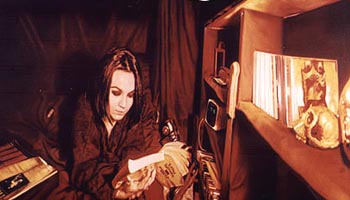David Hancock
dal 7/4/2006 al 12/5/2006
Segnalato da
7/4/2006
David Hancock
The Agency Gallery, London
Hancock’s highly skilled, yet accessible painterly style underlines the futility of rebellion as much as it emphasises its popularity to the point where it does enter the artistic medium in the form of stylisation. Hyper - Realism here adapts both the influences of gothic romanticism as well as those of pop culture in a mix.

Who will eat my sadness
The Agency is pleased to present works by British artist David Hancock. The exhibition features large-scale paintings from 1998 - 2004 as an overview of Hancock’s exceptional work. A new series of Hancock’s works will be presented later in the year at OneTwenty gallery in Gent.
In June this year the National Gallery will open its Rebels and Martyrs show, highlighting romanticism and the visionary outsider in art of the Nineteenth Century. David Hancock might be called that not on the grounds of his technique, but on account of championing the outsider as his subject matter. The outsider in his painting is a temporary one, captured at an age where outsiderism is almost the order, somewhere between the Teens and early Twenties.
What his subjects have in common with the outsider in the Nineteenth century is their presumed isolation acted out in dramatic glory, unafraid of testing boundaries occasionally to the ultimate taboo of suicide. The setting of the splendid isolation of the voluntary outsider in this series is the teenage bedroom or the local train station or park not too far from home. His subjects, in their rebellion against their context, are not identifiable by their actual social background.
In the romantically titled L’Art est Inutile, he depicts the bedroom of a teenager covered with graffiti and posters, cluttered with guitars. The personal environment of this potential Electro fan looks like a bohemian squat, yet it might be situated within an ordinary household, which highlights both his rebellion against that context as well as his private isolation from the world. Hancock becomes the sympathetic voyeur and yet his subject is also a studied expression of Hancock’s artistic self.
Still Ill portrays a girl sitting on a motorway flyover, staring onto the road through metal railings. What is striking in this painting is how Hancock manages to depict her powerful yearning to leave this place behind in a desperate bid for ultimate freedom or self-realisation. Whilst the girl is central to the painting, Hancock pulls back in an almost filmic manner across the whole panoramic landscape, thereby maintaining a careful distance in his gaze.
Painting in the last decade re- explored the territory of popular culture in a painterly style adapted to that end, conceptual and stylish, whereas Hancock allows his subjects personal taste to dictate the outcome of his work with a certain empathy.
Hancock’s highly skilled, yet accessible painterly style underlines the futility of rebellion as much as it emphasises its popularity to the point where it does enter the artistic medium in the form of stylisation. Hyper - Realism here adapts both the influences of gothic romanticism as well as those of pop culture in a compelling mix.
The Agency Gallery
18 Charlotte Road - London



